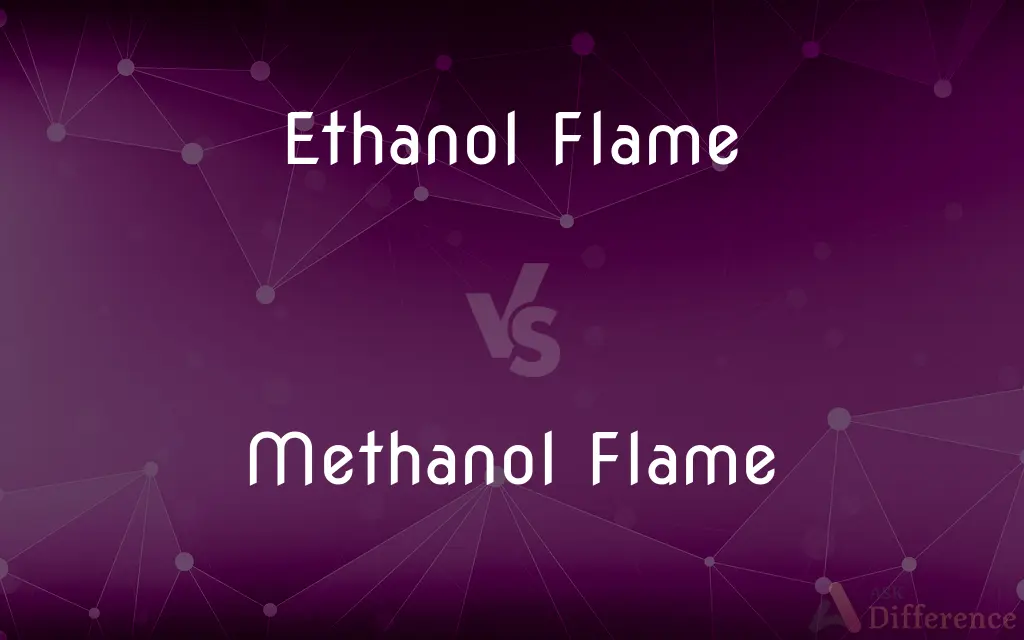Ethanol Flame vs. Methanol Flame — What's the Difference?
By Tayyaba Rehman & Urooj Arif — Published on February 3, 2024
Ethanol flames burn with a blue, nearly invisible flame, while methanol flames are also blue but can produce more toxic byproducts. Ethanol is a common biofuel, and methanol is used in various industrial applications.

Difference Between Ethanol Flame and Methanol Flame
Table of Contents
ADVERTISEMENT
Key Differences
Ethanol flame, produced by the combustion of ethanol, is characterized by a clean-burning, blue flame that is often hard to see in well-lit conditions. In contrast, a methanol flame, resulting from burning methanol, shares a similar blue hue but burns slightly brighter. Both flames are utilized in various applications, yet the ethanol flame is more prevalent in consumer products due to its lower toxicity compared to the methanol flame.
When discussing safety, the ethanol flame is considered safer for indoor use, as its combustion primarily yields carbon dioxide and water. Conversely, the methanol flame, while also used in many applications, poses greater risks due to the release of toxic substances like formaldehyde upon combustion. This inherent difference marks the ethanol flame as a preferable choice for settings prioritizing health and environmental concerns over the methanol flame.
In terms of energy output, the ethanol flame produces a higher heat per unit of fuel compared to the methanol flame, making it a more efficient choice for heating purposes. However, the methanol flame is often noted for its cooler burning temperature, making it suitable for specialized applications where lower temperatures are required. Despite these differences, both the ethanol flame and the methanol flame find their unique niches in various industrial and domestic scenarios.
From an environmental perspective, the ethanol flame is often derived from renewable resources, leading to a lower carbon footprint compared to the methanol flame. Methanol, while also used as a biofuel, is commonly produced from natural gas, making the ethanol flame a more eco-friendly option. This distinction plays a crucial role in the choice between an ethanol flame and a methanol flame, especially in industries aiming for sustainable practices.
Finally, the storage and handling of fuel for an ethanol flame generally require less stringent safety measures than those for a methanol flame, due to ethanol's higher flash point. However, both ethanol and methanol flames require careful management to avoid accidental ignition or poisoning, highlighting the importance of safety in their use. Despite their differences, both the ethanol flame and the methanol flame are integral to various sectors, each with its set of advantages and precautions.
ADVERTISEMENT
Comparison Chart
Visibility
Nearly invisible blue flame
Brighter blue flame
Toxicity of Byproducts
Lower, mostly CO2 and water
Higher, includes formaldehyde
Energy Output
Higher heat per unit
Lower heat per unit
Environmental Impact
Generally lower, often bio-based
Potentially higher, often gas-based
Safety in Handling
Higher flash point, relatively safe
Lower flash point, more precautions needed
Compare with Definitions
Ethanol Flame
Ethanol flame is used in various heating applications due to its clean burn.
The room was lit by the steady glow of an ethanol flame in the fireplace.
Methanol Flame
Methanol flame is the visible, blue combustion of methanol fuel.
The methanol flame burned brightly, offering a stark contrast against the dark room.
Ethanol Flame
Ethanol flame is an eco-friendly alternative in combustion applications.
The camp stove used an ethanol flame, minimizing environmental impact.
Methanol Flame
Methanol flame refers to the heat and light produced when methanol vapor ignites.
They used the methanol flame to quickly boil water while camping in the high altitude.
Ethanol Flame
Ethanol flame refers to the heat and light produced when ethanol vapor ignites.
He warmed his hands, feeling the gentle heat from the ethanol flame.
Methanol Flame
Methanol flame is known for its toxicity and requires careful handling.
Despite the risks, the methanol flame was essential for the precision required in their metalworking process.
Ethanol Flame
Ethanol flame is the result of a chemical reaction involving ethanol and oxygen, producing heat.
The ethanol flame provided a consistent heat source for the outdoor heater.
Methanol Flame
Methanol flame results from a chemical reaction involving methanol and oxygen, producing heat.
The methanol flame is often used in scientific settings for its consistent burning properties.
Ethanol Flame
Ethanol flame is the visible, blue combustion of ethanol fuel.
The ethanol flame flickered subtly under the beaker during the laboratory experiment.
Methanol Flame
Methanol flame is utilized in industrial applications for its high-temperature combustion.
The factory's machinery was powered by the intense heat of a methanol flame.
Common Curiosities
What are the primary byproducts of ethanol and methanol combustion?
Ethanol combustion mainly produces carbon dioxide and water, while methanol combustion can also produce toxic substances like formaldehyde.
What colors are ethanol and methanol flames?
Ethanol and methanol flames both burn with a blue hue, though ethanol flames are nearly invisible, while methanol flames are slightly brighter.
Can both ethanol and methanol flames be used for heating?
Yes, both are used for heating, but ethanol flames are preferred due to higher energy output and cleaner combustion.
Are ethanol flames safer than methanol flames?
Yes, ethanol flames are generally considered safer due to lower toxicity of byproducts and a higher flash point.
Why are ethanol flames considered more environmentally friendly?
Ethanol flames are often derived from renewable resources and produce fewer harmful byproducts compared to methanol flames.
Do both ethanol and methanol flames have similar burning temperatures?
No, methanol flames usually burn at a lower temperature compared to ethanol flames.
Why are methanol flames not commonly used in residential settings?
Due to their toxic byproducts and higher risks in handling, methanol flames are less common in residential settings compared to ethanol flames.
Can ethanol be used as a fuel in places where methanol is traditionally used?
It depends on the application, as each fuel has specific properties and safety considerations.
How visible are ethanol flames compared to methanol flames?
Ethanol flames are less visible and can be nearly invisible, especially in bright light, while methanol flames are a bit brighter.
Is it true that ethanol flames produce more heat than methanol flames?
Yes, ethanol flames generally produce more heat per unit of fuel compared to methanol flames.
Are there any specific safety precautions for storing ethanol and methanol fuels?
Yes, both fuels require careful storage, but methanol is more hazardous due to its lower flash point and higher toxicity.
What are the environmental impacts of using ethanol and methanol flames?
Ethanol flames typically have a lower environmental impact due to their renewable sources and cleaner combustion, whereas methanol flames, often derived from non-renewable sources, can have a higher environmental footprint.
Can ethanol and methanol flames be used interchangeably in industrial applications?
Not always, as they have different properties, such as heat output and toxicity, making them suitable for different applications.
Are ethanol flames completely safe for indoor use?
While safer than many alternatives, proper ventilation and safety measures should always be in place when using ethanol flames indoors.
What makes ethanol flames a preferred choice in consumer products?
Ethanol flames are preferred due to lower toxicity, higher safety, and more environmentally friendly combustion.
Share Your Discovery

Previous Comparison
WAV vs. MP3
Next Comparison
MacBook Air vs. MacBook ProAuthor Spotlight
Written by
Tayyaba RehmanTayyaba Rehman is a distinguished writer, currently serving as a primary contributor to askdifference.com. As a researcher in semantics and etymology, Tayyaba's passion for the complexity of languages and their distinctions has found a perfect home on the platform. Tayyaba delves into the intricacies of language, distinguishing between commonly confused words and phrases, thereby providing clarity for readers worldwide.
Co-written by
Urooj ArifUrooj is a skilled content writer at Ask Difference, known for her exceptional ability to simplify complex topics into engaging and informative content. With a passion for research and a flair for clear, concise writing, she consistently delivers articles that resonate with our diverse audience.














































